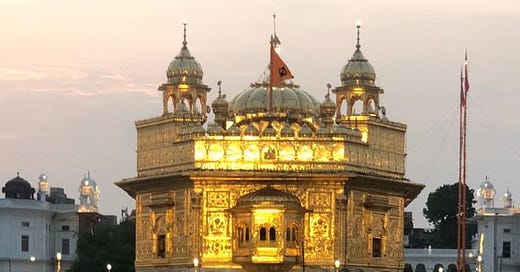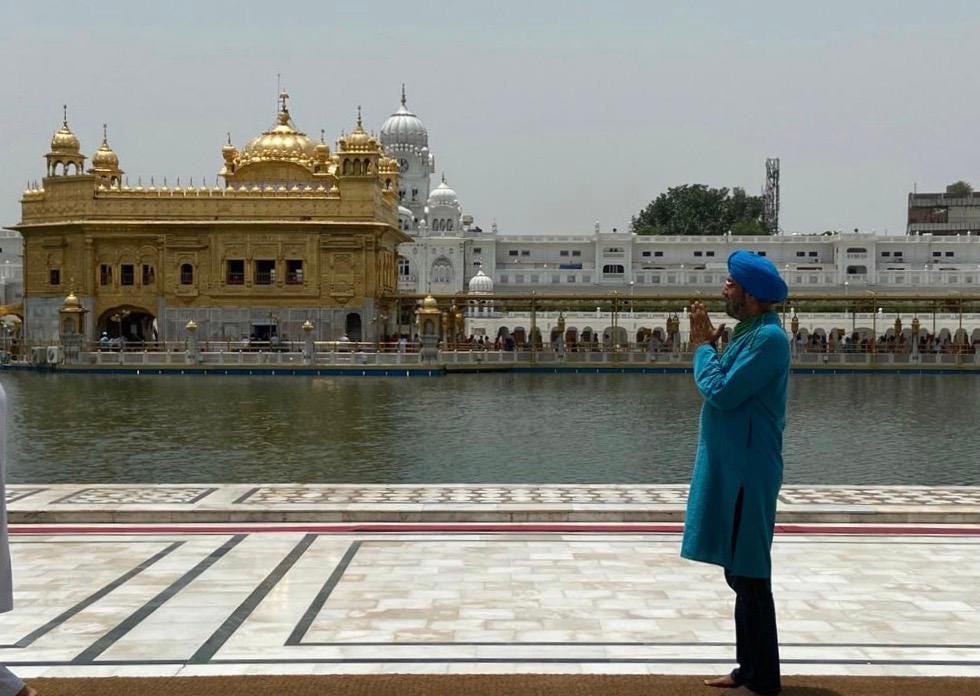Amritsar at 450: The Living Pool of Nectar and Naam
From Guru Ram Das Ji’s founding of Ramdāspur to the eternal voice of Sri Guru Granth Sahib in the Golden Temple, Amritsar remains a beacon where devotion turns geography into grace.
By Karan Bir Singh Sidhu
Retired IAS officer (Punjab cadre), former Special Chief Secretary to Government of Punjab; lifelong student of Sikh history and heritage, with a special interest in the spiritual and civic legacy of Guru Sahiban.
Amritsar — Four-and-a-Half Centuries of Nectar and Naam
In 1577 CE, the fourth Sikh Guru, Guru Ram Das Ji, purchased a marshy tract near the village of Tung, excavated a square pool that he named Amrit-sar (“lake of immortal nectar”), and sketched a township around it called Ramdāspur. Four broad avenues converged on the tank from the four horizons, proclaiming an open welcome to all humanity. The project embodied Sikh ideals of sewā (service), sangat (congregation), and radical equality, and it quickly drew artisans, merchants, and pilgrims into a cosmopolitan frontier bazaar.
A decade later, his son and spiritual successor, Guru Arjan Dev Ji, laid a causeway into the pool and began constructing a sanctuary at its centre—purposely built lower than the surrounding lanes to remind all that humility is the gateway to the Divine. When the Harimandar Sahib (now called the Golden Temple) was completed, Guru Arjan installed the freshly compiled Ādi Granth there in 1604—a scripture gathering the voices of five Gurus1, at that time, along with those of saints from various traditions. This made the Golden Temple the first Sikh gurdwara where the Guru Granth itself would preside as the eternal Guru.
Ramdāspur in the Guru’s Own Words
ਅੰਗ 1362 – Phunhe M5
ਵਸਦੀ ਸਘਨ ਅਪਾਰ ਅਨੂਪ ਰਾਮਦਾਸਪੁਰ ॥
vasadī saghan apār anūp Rām-dāspur
“Ramdāspur is prosperous, boundless, matchless.”
Guru Arjan’s verse celebrates more than bricks and mortar; it hails a living fellowship where devotion makes prosperity inseparable from spiritual beauty.
ਅੰਗ 625 – Sorath M5
ਰਾਮਦਾਸ ਸਰੋਵਰਿ ਨਾਤੇ ਸਭਿ ਉਤਰੇ ਪਾਪ ਕਮਾਤੇ ॥
Rām-dās sarovar nāṭe, sabh uṭre pāp kamāṭe
“Bathing in Ram Dās’ pool, all sins are washed away.”
Yet this "bathing" is no ritual dip of the body alone; it is the immersion of the mind in Naam within the fellowship of the saadh-sangat.
ਅੰਗ 493 – Gujrī M4
ਅੰਮ੍ਰਿਤ ਸਰੁ ਸਤਿਗੁਰੁ ਸਤਿਵਾਦੀ ਜਿਤੁ ਨਾਤੈ ਕਊਆ ਹੰਸੁ ਹੋਹੈ ॥
Amrit sar Satgur sativādī; jit nāṭe kauā hans hohai
“The True Guru is the pool of ambrosial nectar; bathing in it, the crow becomes a swan.”
By surrendering ego and absorbing the Guru’s wisdom, even the spiritually barren (kauā—crow) is transformed into the pure and discerning (hamsa—swan).
From Poison to Nectar: Lahore and the Geography of Redemption
On ਅੰਗ 1412, two seemingly contradictory saloks appear sequentially—one composed by Guru Nanak Dev Ji, the immediately next by Guru Amar Das Ji—yet consciously placed in this manner by Guru Arjan Dev Ji when compiling the Ādi Granth:
27 – “ਲਾਹੌਰ ਸਹਰੁ ਜਹਰੁ ਕਹਰੁ ਸਵਾ ਪਹਰੁ ॥”
“Lahore reeked of poison and ruin for the span of a watch.”28 – “ਲਾਹੌਰ ਸਹਰੁ ਅੰਮ੍ਰਿਤ ਸਰੁ ਸਿਫਤੀ ਦਾ ਘਰੁ ॥”
“The same Lahore became Amrit-sar, a house of divine praise.”
Even a city like Lahore, steeped in violence and spiritual decay can, through awakened consciousness, transmute into a fountain of hymn and healing—a timeless lesson the Gurus wove into Punjab’s very geography. (A more detailed discussion of these paired verses is offered in our dedicated YouTube analyses.)
Living Waters: the UBDC–Hanslī Lifeline
Historically rain-fed, the sacred Amrit Sarovar was vulnerable to summer drought. In the late nineteenth century, British engineers constructed a narrow channel—the hanslī (“little jugular”)—to draw water from the Upper Bari Doab Canal (a branch of the Ravi River) into the pool. This ensured perennial flow.
Later, a concrete hanslī built in the 1990s, supplemented by deep tube-wells and a modern filtration plant (installed during the 2004 kar-seva), now sustains not only the main sarovar but also the city’s four ancient sibling tanks: Santokhsar, Ramsar, Kaulsar, and Bibeksar. Periodic desilting of the hanslī, especially near Tara Wala Pul, keeps this life-giving artery flowing clear, ensuring that the 31 million litres of the Sarovar continue to shimmer in living testimony to the city’s name—Amrit-sar.
Amritsar: The Throne of Eternal Guru Granth Sahib
Today the Golden Temple remains the luminous heart of the Sikh world: where kirtan has resonated unbroken for centuries, where langar daily rescinds hunger and hierarchy, and where the Guru Granth Sahib presides not merely as scripture but as eternal living Guru.
For Sikhs across five continents, Amritsar is more than birthplace or pilgrimage; it is the threshold where individual spirit meets collective destiny. Each humble step upon the marble parikrama, each reflection cast upon the Sarovar’s still waters, draws the pilgrim deeper into a timeless covenant—first struck by Guru Ram Das Ji lifting soil from a swamp, and by Guru Arjan Dev Ji gathering wisdom into the Ādi Granth: that wherever Naam, Sangat, and Sevā are truly enshrined, poison turns to nectar, strangers to kin, and cities into beacons of Divine presence.
The sacred hymns of Sri Guru Tegh Bahadur Ji (Salok Mahala 9) were later incorporated by Guru Gobind Singh Ji when he revised and sanctified the holy Granth at Damdama Sahib.





